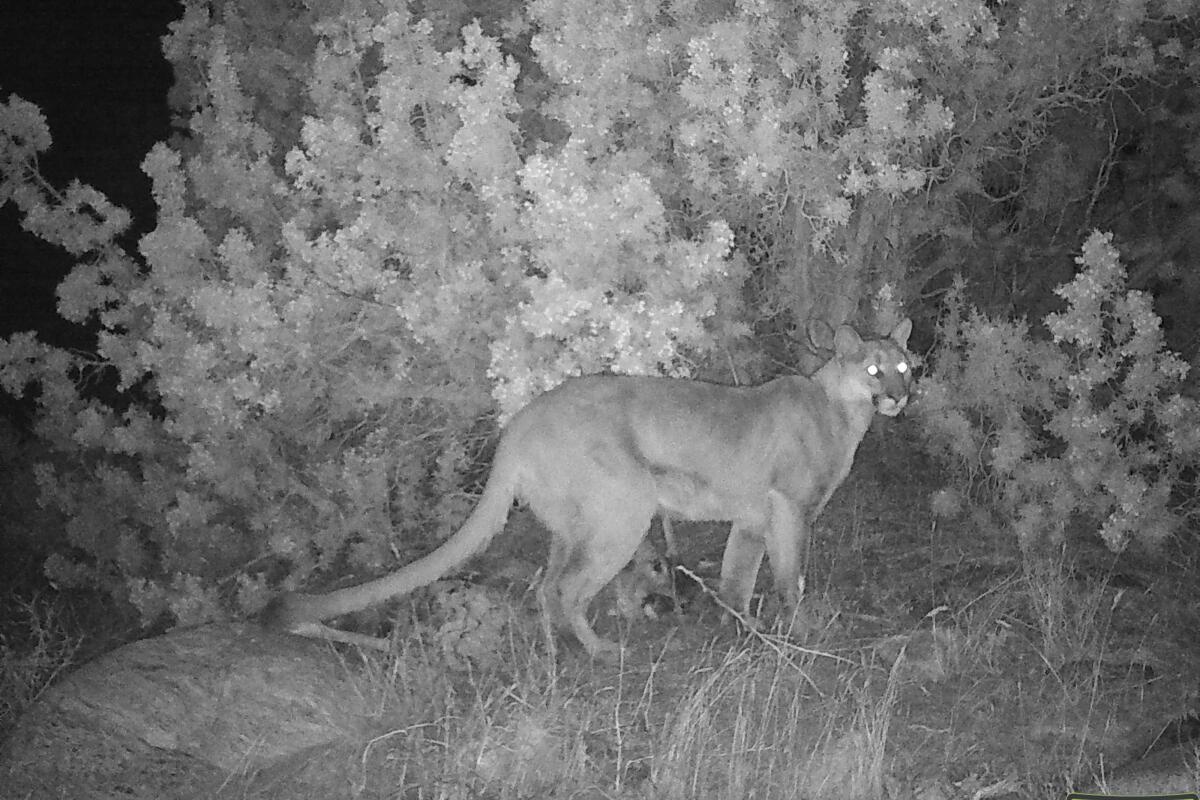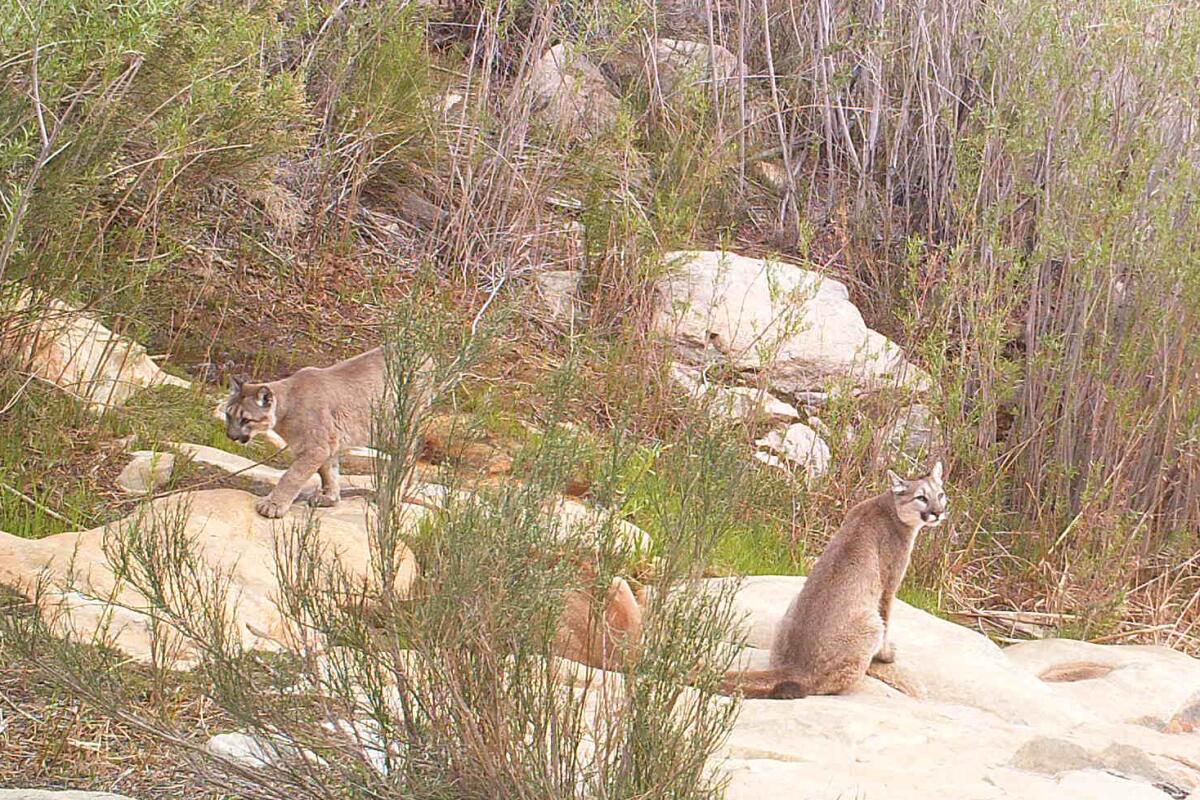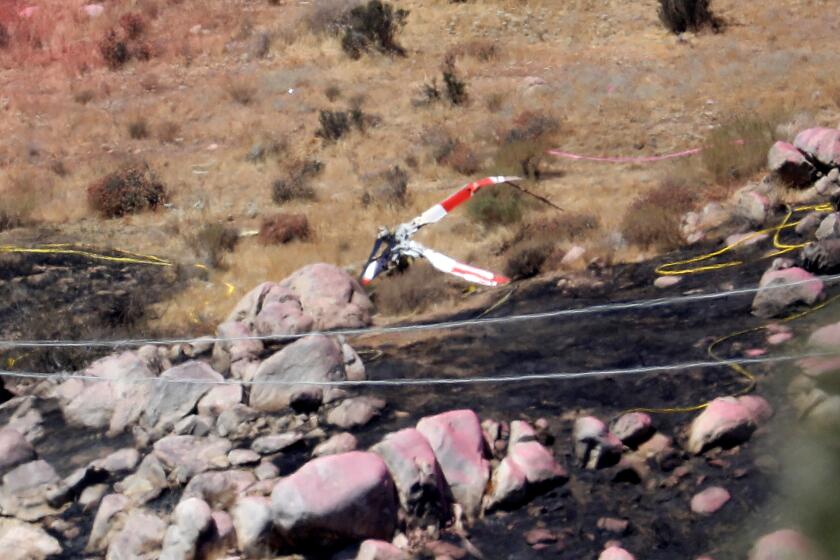Why did California officials drop two mountain lions in the desert and leave them to die?

- Share via
In the face of mounting outrage from environmentalists, state wildlife officials have revised their policies for translocating mountain lions after two male cougars were captured in the eastern Sierra Nevada and relocated to the Mojave Desert, where they died of starvation.
In a decision that has been described as both “disturbing” and “bizarre,” a pair of mountain lions designated as L147 and L176 were trucked roughly 210 miles from their home range and released in the desolate Mescal Mountains.
In an apparent bid to reunite with their mountain lion mates, the cougars began making their way back to their home range and entered a desert area with little to no prey.
L147 was found dead on March 29, 2021, “in an emaciated condition suggesting starvation as a cause of mortality,” the report said. L176 was found later in extremely emaciated condition and “had to be euthanized” on May 12.
“In hindsight, it wasn’t a good place to release those lions,” said Tom Stephenson, a senior environmental scientist at the California Department of Fish and Wildlife, “and we’re not moving them to that environment anymore.”
The Eastern Sierra Nevada has braced for snowmelt flooding since spring. Forecasters say the region’s waterways should return to normal by next month.
Also, the department will no longer move male lions, because they are prone to bolt back to their home ranges, pushed by instinct to guard females from the advances of other males.
Furor over the animals’ fate erupted after details emerged in a recently published 2021 annual report on the California Department of Fish and Wildlife’s Sierra Nevada Bighorn Sheep Recovery Program, which is tasked with ensuring viable populations of both federally endangered bighorns and their charismatic predators.
That report detailed the capture of the two cougars, who were attacking bighorn sheep, and said their relocation sites south of Interstate 15 were chosen as part of an effort to gather data that might prove a boon to the placement of wildlife crossings along a stretch of the freeway targeted for development of a high-speed rail linking Southern California to Las Vegas.

Subscribers get exclusive access to this story
We’re offering L.A. Times subscribers special access to our best journalism. Thank you for your support.
Explore more Subscriber Exclusive content.
The report acknowledged that “more important and practical factors which should influence mountain lion behavior, such as prey availability and habitat familiarity, received less consideration.” Consequently, the cougars “struggled to find prey in an unfamiliar environment.”
A benefit of the experiment, the report noted, was that “Both L147 and L176 used separate underpasses to cross I-15, demonstrating the importance of wildlife crossing corridors on major highways.”
Criticism of the report was swift. Mountain lion advocates said the effort caused the animals unnecessary suffering to support a conclusion that seemed obvious.
“The deaths of the mountain lions noted in the report are tragic, and reading about their deaths made my heart hurt,” said Brent Lyles, executive director of the Mountain Lion Foundation.

“Looking back on the end result, I wish they had considered more factors, like habitat suitability for those particular lions,” he said. “But I’m sure those researchers feel the same way, looking back on their actions in hindsight.”
After the Los Angeles Times inquired about the incident, Stephenson, who oversees the Sierra bighorn recovery program, said the report falsely characterized the cougars’ relocation as an experiment to see if they could return to their home ranges by crossing the I-15. The report was hastily written by staffers on deadline and largely inaccurate, he said.
He said a new 2022 annual report on the Sierra bighorn recovery program published on Wednesday included a section intended to “clarify” the matter.
Sign up for This Evening's Big Stories
Catch up on the day with the 7 biggest L.A. Times stories in your inbox every weekday evening.
You may occasionally receive promotional content from the Los Angeles Times.
According to the new report, the cougars were translocated “as an alternative to lethal removal” by shooting or chemically induced euthanasia.
“Given their homing instinct, the hope was that the Mojave Desert would function as a barrier to prevent their return to the Sierra,” the report said.
“The region of the eastern Mojave where they were moved has adequate prey to the southeast,” the new report said. “Unfortunately, their homing instinct drove them to return to the northwest,” where prey was harder to find.
Justin Dellinger, who was a senior environmental scientist at the state Wildlife Investigations Laboratory at the time, said he “recommended lethal removal as the most humane way of dealing with these lions.”
“That’s because I believed that moving them would likely result in what ultimately happened, which is disturbing,” he said.
One of two firefighting helicopters involved in a fatal midair collision last week lacked an electronic warning device that alerts pilots to nearby aircraft.
Mark Elbroch, a mountain lion biologist and author of the book “The Cougar Conundrum: Sharing the World with a Successful Predator,” described the effort as “an admittedly bizarre way to study connectivity, followed by an attempt to paint a silver lining on the stress and slow death of these lions.”
Stephenson would not go that far. But in an interview, he said, “It would never have happened if we knew then what we know now.”
“We knew this would be a touchy situation, but we’re in the difficult position of trying to restore entire populations and maintain the integrity of ecosystems,” he said.
The life and times of mountain lions and Sierra Nevada bighorn sheep embody the agonizingly complex issues facing wildlife managers in California.
“Humans have so disrupted natural systems that we’ve left endangered animals clinging to existence on shrinking islands of habitat,” said Wiston Vickers, a veterinarian at the UC Davis Wildlife Health Center.
“Then we try to fix things as best we can in often imperfect ways.”
New to L.A. and looking for a place to live, I had to quickly educate myself on the region’s largest polluters, its many microclimates and its topography.
In 2019, state wildlife authorities counted 54 mountain lions prowling in the rocky alpine domain of Sierra Nevada bighorn sheep, the highest count to date.
At risk was a population of Sierra Nevada bighorn sheep that has shown a remarkable comeback since it was reduced to about 100 animals in 1995. But full recovery may take up to 38 years, cost tens of millions of dollars and require aggressive predator management strategies, according to a government cost-benefit analysis.
L147 and L176 were part of a group of lions translocated in early 2021 that included a female with two kittens, officials said. The female was struck by a vehicle and died shortly after she was turned loose in the Slinkard/Little Antelope Valley Wildlife Area, about 37 miles east of Lake Tahoe, officials said. The fate of her kittens remains unknown.
The two collared males were initially released in separate areas, roughly 100 miles north and south of their home ranges, officials said. But both immediately began “traveling in straight lines” back toward their respective territories, the report said.
“These lions were going to head back home no matter where we put them,” Stephenson said. “We’ve been more successful moving females.”
Mountain lions as a species are not threatened in California, but the state Fish and Game Commission has granted cougars in six regions from Santa Cruz to the U.S.-Mexico border “candidate status” to be listed as threatened sometime next year.
The action came in response to a petition co-sponsored by the Center for Biological Diversity and the nonprofit Mountain Lion Foundation. It argues that six isolated and distinct cougar clans within those regions make up a subpopulation that is threatened by extinction.
Now, state officials and environmentalists alike worry that the controversy surrounding the deaths of L147 and L176 may complicate proposals to boost the reproductive rate of increasingly isolated and inbred puma clans in Southern California by moving eastern Sierra Nevada lions into their territories.
“We’ll gladly move some of the eastern Sierra Nevada lions to Southern California to help boost that population’s genetic diversity,” Stephenson said. “If that were to occur, however, I’m sure that some of those lions would be hit by cars.”












